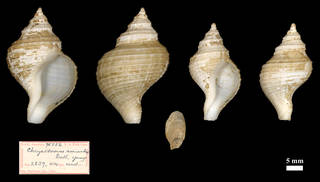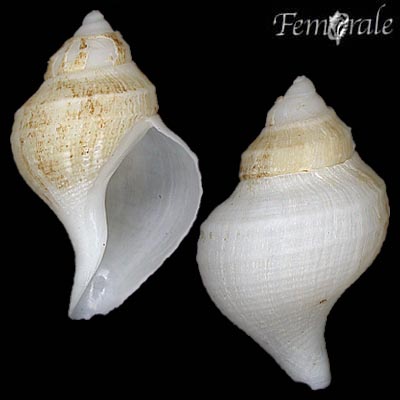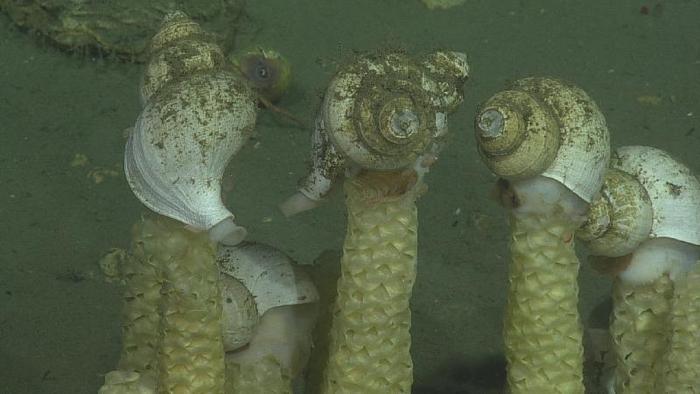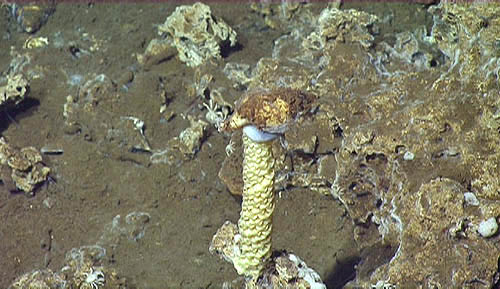The God of the Sea is a snail 1/n
The aptly named gastropod Neptunea amianta (Dall, 1890) is a deep-water species found off the North American west coast. Although typically in colder water, the range extends as far south as Punta San José, Baja California. 2/n
This snail is is totally deep-water exclusive found at depths usually between 300 and 1500m. 3/n
Image from @FemoraleShells
Image from @FemoraleShells
In approximately 15 years of video sampling by @MBARI_News with remote operated vehicles in Monterey Canyon, N. amianta has been documented from 100-3500m, yet dense aggregations, uncommon in deep-sea snails, seem to occur only between 200-2000m. 4/n
This range extends the species into the oxygen minimum zone, where oxygen concentrations of the water column fall to such depleted levels that many species are unable to survive here or require special physiological adaptations. 5/n
My previous research indicates that low oxygen concentrations can reduce shell size in Atlantic deep-sea gastropods http://craigmcclain.com/wp-content/uploads/2016/01/McClain_MAR-BIOL_20011.pdf; nonetheless, N. amianta, is a giant compared to other deep-sea gastropods obtaining shell heights of a whopping 6cm! 6/n
Typical of its family, N. amianta is scavenger and dense aggregations in Monterey Canyon have been associated with every conceivable type of large organic matter such as dead crabs, dead whales, dead cold seep clams, kelp, and wood. 7/n
But here is where the story gets really freaky, the species has amazing fasting potential. 8/n
In one experiment, 5 individuals of N. amniata survived 12 months in aquaria without food! After which the experiment was terminated. 9/n https://www.sciencedirect.com/science/article/pii/S0967063799000448
All 5 individuals displayed no clear signs of undernourishment and one even produced a large egg case with ~75 juveniles during the seventh month!!! 10/n
The remarkable fasting potential and the ability to utilize any food resource are likely responsible for its large depth range and high density. 11/n
To recap, the snail Neptunea amniata is amazing because
1. It obtain a large size even under low oxygen
2. It can survive without food for potentially over year and still produce eggs and a egg case.
3……. 12/n
1. It obtain a large size even under low oxygen
2. It can survive without food for potentially over year and still produce eggs and a egg case.
3……. 12/n
Number 3 is where this snail really takes the cake. Snails in this family have separate males and females with fertilization occurring internally. 13/n
Females can produce over 1000 eggs in a leather capsule. In N. amianta, egg capsules are stalked and typically 15-25cm high. 14/n
Photo from @MBARI_News I believe
Photo from @MBARI_News I believe
Multiple stalked capsules, laid by separate females, are found grouped on a hard substrate such as rock outcropping. 15/n
The utilization of hard substrate may serve the dual purpose of providing a stable base and allow the egg capsule to extend higher off the bottom into more oxygen rich water. The core of the egg stalk is hollow further allowing for oxygenation of the the egg mass. 16/n
But here is where thing get a bit gruesome, in Neptunea, the first few juveniles to emerge from the capsule will quickly consume unhatched individuals. 17/n
A perfect adaptation in the food poor deep sea to start the kids off with a buffet! They won’t need to eat for another year! 18/n
To recap, the snail Neptunea amniata is amazing
1. It obtains a large size even under low oxygen
2. It can survive without food for potentially over a year and still produce eggs.
3. It lays a foot high egg cases.
4. The juveniles will cannibalize thier unborn brethern.
1. It obtains a large size even under low oxygen
2. It can survive without food for potentially over a year and still produce eggs.
3. It lays a foot high egg cases.
4. The juveniles will cannibalize thier unborn brethern.

 Read on Twitter
Read on Twitter





